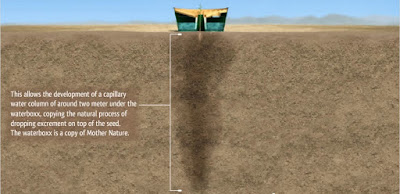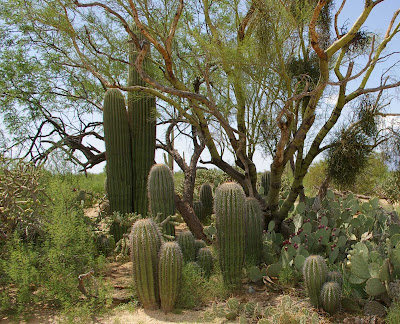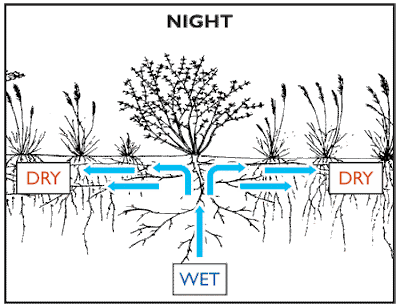
For those keenly aware of their surroundings when you're out walking in Nature, you will always find that companion planting is very common. That's what makes various ecosystems everywhere so very unique and successful. Humans now are finding this out as they reverse engineer many of these systems through mistakes introduced by previous bad science which has allowed invasive plants to disrupt these systems. This has happened on every single continent on this planet. The early Native Americans knew the value of companion planting when they created farming systems known as "The three Sisters Farming" no doubt from their observations of how things worked well together in the natural world. In theory, the three sisters crops benefit from each other. The maize provides a structure for the beans to climb, eliminating the need for poles. The beans provide the nitrogen to the soil that the other plants use, and the squash spreads along the ground, blocking the sunlight, helping prevent establishment of weeds. The squash leaves also act as a "living mulch", creating a microclimate to retain moisture in the soil, and the prickly hairs of the vine deter pests. But again, this pattern is an unmistakable part of Nature found repeatedly over and over for 10s of 1000s of years. So what happened ?
 |
| CaliforniaChaparral.org |
A California Biologists Perspective - Bert Wilson
"Permaculture, Agroforestry, and Agroecology. These words have many characteristics in common, in terms of agriculture. The concepts from permaculture (permanent agriculture), agroforestry (growing tree crops and vine, field crops together), agroecology (study of agriculture using the basic ideas of ecosystems) are all interrelated. If you think about it, each of these systems is moving agriculture (growing living organisms for the benefit of man) closer to the natural world. The missing component is the integration of wildland plants into the mix. Every time you remove wild habitat, the agriculture suffers in that area; maybe in small ways, but small ways add up to big ways. For example, researchers have found that having strips, or areas of wild plants adjacent to, or growing within field and orchard crop areas support native pollinators such as bees and flies that help to increase pollination of the crops and so increase crop yields."
"Wild plants may support some of the predators and parasites that prey on your agricultural crop pests, and add stability to the immediate habitat, by redundancy. The cultivation of agricultural plants has, by definition, probably net negative impacts on an ecosystem (the practice of agriculture removes soil nutrition from an area, and decreases biological diversity, from microscopic soil organisms to large mammals). Incorporating indigenous plants adjacent to agricultural plantings supports more variety of beneficial organisms, and increases biological diversity, and can add nutrition to the site. Then, if one plant or animal fails one year, there are others to perform that function temporarily. So the 'plant-animal community' of cultivated plants, naturalized and indigenous plants and animals small and large, and other organisms, can recover from adversity more quickly, and reduce adversity's effects. Another analogy is that this plant-animal grouping is like a giant web; if one strand of the web fails, there are other strands to hold the web together. The more interlinking strands, the stronger the web. Also, in terms of humankind, there may be some species, even though we don't realize it now, that could help us to survive in the future. So it is to our advantage to save all the natural habitat that we can. One way is to integrate wild plants into the edges of our gardens, fields, and orchards. Instead of just mimicking nature, how about including nature?"
(Source)
 |
| Image - laspilitas.com |
Mainpost on Groasis Waterboxx Technolgy and it's incredible potential
~~~~~~~~~~~~~~~~~~~~~~~~~~~~~~~~
This is what happens when science-based practices are shackled to Corporate Business InterestsFor the past 100+ years, human technological innovation has attempted to harness nature in making what the industry leaders decades ago have always viewed as improving Nature's flaws.
 |
| Image - Utah Wildlife |
Of course the theory behind site preparation and grinding up all vegetation into a mulch by a giant Balldozer pulling a roller is that this will (in their imagination) ensure no competition and the resulting nutrients feeding the trees. In actuality they've just eliminated the very mechanisms which would have helped the tree seedling/saplings survival
 |
| D-9 Bulldozer site preparation |
Same misplaced theory for deep ripping the soil in site preparation. Ensure that no chaparral lignotubers and roots are left to resprout and compete with their precious plantation trees.
 |
| D-9 Bulldozers ripping baparral with anchor chain |
Old time outdated irresponsible method for site preparation. Even still, many a practices today are deeply entrenched in the mind of those employed with the Industrial Forestry business model.
 |
| Dave Powell, USDA Forest Service (retired) |
This scene above looks almost exactly like Garner Valley in the San Jacinto Mountains where I once lived for 20+ years. They actually disked this Jeffrey Pine forest floor like this periodically. However this photo is in actually what the US Forest Service calls a scarification program which was done by disking to expose bear mineral soil, as in this ponderosa pine stand in the Pike National Forest of Colorado. Their theory was that establishing newer trees needed site preparation by mechanical seed bed preparation and competition control which they felt was necessary to establish the new pine seedlings. Garner Valley has had numerous such projects done exactly the way you see above. The process ultimately was chaparral cutting, disking, then mulching and smoothing of the ground. Pines were then planted and had to be maintain by hand watering the first couple years by Forest Service personel using an old time farm caterpillar pulling what is known as a Water Buffalo Trailer which were military surplus items provided such government agencies after World War II for their conservation work. Throughout the 1980s, I drove past numerous tree planting projects by the U.S. Forest Service along Hwy 74 through Garner Valley and watch them rip up the landscape of all chaparral, disk & mulch organic material left over and smooth out the surface in preparation of tree planting. After planting for the next two years they used an old Ford Tractor or WWII Farm Caterpillar to pull one of these Water Buffalo Trailers and hydrate the pine seedlings by hand over countless acreas.
 |
| Image - publicsurplus.com Old time Army Water Buffalo Trailer |
The Chaparral Institute has done an incredible job of documenting many of these irresponsible outdated practices as used by the U.S. forest Service and Timber Industries whose goal is servicing the land as a monocropped agricultural program. It doesn't matter if their justification claims to be science-based. People are going to have to stop using the term Science in the general sense and understand that many will misuse and abuse that term in justifying a commercial business model. Take note of the terrible aftermath of the 2003 Cedar Fire in San Diego County California and the attempts to reforest Cuyamaca State Park which lost most of it's forests in the video below. Notice the ignorance displayed in attempts at obliterating all chaparral believed to be a major invasive competitor of forest tree re-establishment.
Chaparral Institute: Loss in Cuyamaca Rancho State Park
~~~~~~~~~~~~~~~~~~~~~~~~~~~~~~
How the Groasis-Waterboxx can rapidly speed up the process of companion planting
 |
| Image - Goasis.com |
 |
| Oregon State University |
| by Bob Harms - University of Texas Mexican Barberry (Algerita) Berberis trifoliolata (Mahonia) |
Lignotuber: "A rounded woody growth at or below ground level on some shrubs and trees that grow in areas subject to fire or drought, containing a mass of buds and food reserves."
Nobody ever considers the underground rooting network infrastructure and the successes this creates if grown correctly and they should. Especially where I come from where climate change made worse drought conditions are making it more and more impossible to maintain a healthy good looking urban landscape. People everywhere in dryland regions should seriously start looking for shrubs which would make the best Nurse plant companions to trees they wish to plant. And good looking native ornamentals should be researched first before considering some long time traditional retail nursery alternative.
 |
| Image - Groasis.com |
The Green Deserts' research project in Spain
| Image - Goasis.com |
 |
| Image - Goasis.com (Biodegradable Goasis Cocoon) |
 |
Okay yes, size does matter |
Reforestation Groasis waterboxx desert planting experiment with Palm Springs School District
| Image - familthandyman.com |
When planning your urban landscape you need to think smart. Everyone wants instant landscape, but at what cost ? The tall tree in the burlap wrapping as the above example should always be rejected in favour of something which will out perform it on the road to life with far less maintenance and care. Also there is less danger of large trees with spiraled girdling root systems which will easily blow over in wind storms.
The Native California Plants used in three different habitat restoration experiments
Whitewater (High Desert), Mission Springs (Low Desert), Dos Palmas (Salton Sea), in Southern California
Honey Mesquite -- Prosopis glandulosa
Screwbean Mesquite -- Prosopis pubescens
Blue Paloverde -- Parkinsonia florida
Sugarbush – Rhus ovata
Velvet Ash – Fraxinus velutina
California Sycamore – Platanus racemosa
Holly Leaf Cherry - Prunus ilicifolia
Wishbone Bush - Mirabilis bigelovii
Cheesebush - Hymenoclea salsola
Paperbag Bush - Salazaria mexicana
Beargrass - Nolina parryi
Joshua Tree - Yucca brevifolia
Apricot Mallow - Sphaeralcea ambigua
Groasis: You can also cooperate in your own Groasis Tesform Experiment
~~~~~~~~~~~~~~~~~~~~~~~~~~~~~~~~~~~
Gallery of successful plant companions, both for natural biomimetic replication in urban landscaping or habitat restoration
 |
| Image - Kevin Franck (2013) Jeffrey & Coulter Pines planted in among Redshank, Sugarbush, Scrub Oak, Chamise Chaparral plant community back in 1983 in Anza Ca, (Terwilliger area) |
| Image - Kevin Franck (El Cajon, CA 2013) Torrey Pine & Laurel Sumac Rattlesnake Mountain - El Cajon, California |
| Image - Kevin Franck Cuyamaca Cypress in Chaparral Community (Adenostoma, Quercus, Cercocarpus) |
 |
| Image by Game Warden Bill Bish Indian Paint Brush with Artemesia-Sagebrush |
An Icon of the Old West, Sagebrush (Atermisia tridentata) is Still Demonized as a Competing Invasive in it's Own Native Habitat
 |
| Image - Tarelton State University Antelope Bitterbrush & Pine Tree |
 |
| Image - María Florencia Urretavizcaya, Guillermo E. Defossé Austrocedrus chilensis (Chile - Argentina) |
 |
| Image by J. Deacon - University of Edinburgh Oagan Pipe Cactus in Palo Verde |
 |
| Image - National Park Service Saguaro National Monument |
The Sonoran Desert studies on companion trees and nurse plants are beautiful examples of how Nurse Plants work and operate in real time. The interesting phenomena of Hydraulic Lift & Redistribution are also points to consider when planning any type of project whether urban landscaping or habitat restoration. And let's not forget the winter dormancy phenomena of hydraulic descent where rainy season moisture is pumped deep into the earth's subsoil layers in recharging subterranean moisture reserves. The goal here is not only immediate and long term survival success, but also the elimination of time wasting and expensive hands on on maintenance. Even in human societies, giving someone a hand up towards sustainable independence is far better than continued welfare hand outs which keeps people on lifesupport.
Hydraulic Descent An Ecosystem's Tool for Filling Vast Underground Reservoirs
Roots: 'Hydraulic Lift and Redistribution'
There is incredible potential for reversing the damage humans have done to the Earth using such a technology as Groasis Waterboxx. But only human leadership (Politics, Scientists, Religion, Corporations, etc) stands in the way. The average person follows leadership /good or bad). Radical change in this world's leadership is imperative.
Update July 16th 2016
Anti desertification and reforestation with the Growboxx plant cocoon
~~~~~~~~~~~~~~~~~~~~~~~~~~~~~~~~~~~~~~~~~~
| Credit: Arizona Geologist Wayne Ranne Jodhpor India, Acacia & Prosopis trees can stabilize Sand Dunes and Badlands |
~~~~~~~~~~~~~~~~~~~~~~~~~~~~~~~~~~~~~~
Other Valuable Resources for Urban Landscape Companion Planting & Research Studies
https://www.groasis.com/en
LasPilitas.com - Native Plant Communities and Companion Plantings
LasPilitas.com - Easy Companion Planting & Important Things to Know
Lavandula species as accompanying plants in Cupressus replanting strategies: Effect on plant growth, mycorrhizal soil infectivity and soil microbial catabolic diversity
Effects of nurse shrubs and tree shelters on the survival and growth of two Austrocedrus chilensis seedling types in a forest restoration trial in semiarid Patagonia, Argentina



No comments:
Post a Comment
Thanks for visiting and stopping by with your comments!
I will try to respond to each comment within a few days, though sometimes I take longer if I'm too busy which appears to be increasing.